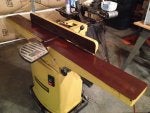There was some interest in another thread on using electrolysis so I thought I'd post how/what I did on my PM jointer rather than hijacking that thread. I am certain you can Google this and find many variations to this process but this worked for me so I'm good with my method, but feel free to chime in and show how you've done this.
A few years ago I picked up a PM 54A jointer found on CL. The jointer had been in a non-climate controlled storage building and subject to humidity so it had what I thought was surface rust. When I got it home I realized the rust was a little more than I had initially realized.
When I brought it home it looked like this (soaked with WD-40 in this photo) -
![]()
Kind of heavy in some areas -
![]()
Ugly spot there in front of the cutterhead, which doesn't look too good, either -
![]()
Here's the cutterhead out of the jointer -
![]()
What I have here is a towel wetted with water and baking soda. I don't remember how much but in a 5 gallon pail I think I used about 2 gallons of water and about 1/4 to 1/2 cup of baking soda. I wrung the towel out about 75% and placed a sacrificial sheet metal plate I picked up at Lowe's on top of the towel. Then I hooked my battery charger, one lead to the jointer and one to the metal plate. Then I placed some weight on the metal plate to make sure there was good contact. In this case I used some Honduras Mahogany cutoffs from some columns.
![]()
After about 3-4 minutes the amperage gauge goes to about nothing which indicates the towel is now dry and has done all it is going to do. This is after removing the towel and no additional effort applied to the bed other than using the same towel to wipe the bed where the rust was.
![]()
Far less rust, looks pretty good -
![]()
Here's the cutterhead wrapped in a rag and with bailing wire wrapped tightly to make sure there is good contact. I hooked the leads up, gave it 3-4 minutes, and pulled the rag off.
![]()
Here's the cutterhead after Electrolysis and a little buffing with a Scotch-Brite pad -
![]()
And here's the finished machine. Looks good, runs good, and not a lot of effort to clean up using this process.
![]()
Thanks for reading!
David
A few years ago I picked up a PM 54A jointer found on CL. The jointer had been in a non-climate controlled storage building and subject to humidity so it had what I thought was surface rust. When I got it home I realized the rust was a little more than I had initially realized.
When I brought it home it looked like this (soaked with WD-40 in this photo) -

Kind of heavy in some areas -

Ugly spot there in front of the cutterhead, which doesn't look too good, either -

Here's the cutterhead out of the jointer -

What I have here is a towel wetted with water and baking soda. I don't remember how much but in a 5 gallon pail I think I used about 2 gallons of water and about 1/4 to 1/2 cup of baking soda. I wrung the towel out about 75% and placed a sacrificial sheet metal plate I picked up at Lowe's on top of the towel. Then I hooked my battery charger, one lead to the jointer and one to the metal plate. Then I placed some weight on the metal plate to make sure there was good contact. In this case I used some Honduras Mahogany cutoffs from some columns.

After about 3-4 minutes the amperage gauge goes to about nothing which indicates the towel is now dry and has done all it is going to do. This is after removing the towel and no additional effort applied to the bed other than using the same towel to wipe the bed where the rust was.

Far less rust, looks pretty good -

Here's the cutterhead wrapped in a rag and with bailing wire wrapped tightly to make sure there is good contact. I hooked the leads up, gave it 3-4 minutes, and pulled the rag off.

Here's the cutterhead after Electrolysis and a little buffing with a Scotch-Brite pad -

And here's the finished machine. Looks good, runs good, and not a lot of effort to clean up using this process.

Thanks for reading!
David





